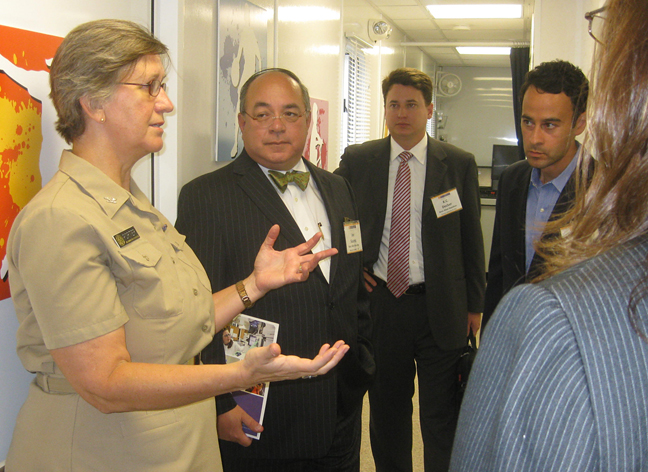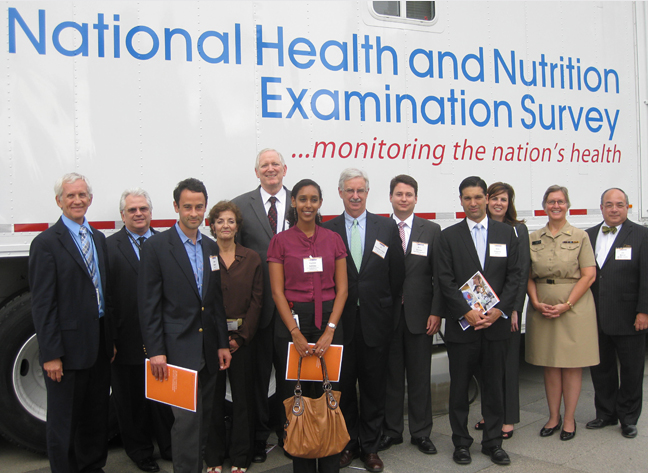You are here
Tour Highlights Business Connection for CDC's National Health Research
 You may be old enough to remember when gasoline contained lead or when people smoked cigarettes in the office like an episode of Mad Men. If these memories are before your time, however, I’m sure you’ve seen recent articles noting the prevalence of obesity and high blood pressure in adults as well as higher levels of sodium in children’s diets in the United States.
You may be old enough to remember when gasoline contained lead or when people smoked cigarettes in the office like an episode of Mad Men. If these memories are before your time, however, I’m sure you’ve seen recent articles noting the prevalence of obesity and high blood pressure in adults as well as higher levels of sodium in children’s diets in the United States.
Ever thought about where the information came from to inform those articles or the policy changes aimed at eliminating lead in gasoline and efforts by employers to reduce exposure to second-hand smoke in the workplace? It’s from data collected through the Centers for Disease Control and Prevention’s (CDC) National Health and Nutrition Examination Survey (NHANES), which assesses the health and nutrition of the U.S. population based on an annual representative sample of 5,000 participants.

What distinguishes NHANES, in addition to its 50-year history of tracking America’s health and nutrition, is that it combines interviews with actual physical exams and laboratory tests. Health interviews are conducted in respondents’ homes, while physical exams and lab tests are conducted in mobile centers – think high-tech tractor trailers – that travel to 15 preselected cities every year.
In September, the NHANES mobile exam centers converged on Washington, D.C., within sight of the U.S. Capitol. Last week, I was pleased to lead about a dozen Washington business and civic leaders on a CDC Foundation-sponsored tour of the NHANES trailers.
Sure, this tour offered a glimpse into one aspect of CDC’s work – the portion focused on detecting, monitoring and conducting research into health problems. But the NHANES data is also essential to informing businesses about the health trends of the U.S. population today and providing a glimpse into where these trends may be headed tomorrow.
Past surveys have provided businesses with information to inform their health and wellness plans as well as their business plans. A few examples:
- Businesses from airlines to clothing manufacturers to toy producers have used NHANES measurement statistics to develop sizing for the various products they design and manufacture.
- The prevalence of obesity noted in NHANES has led to the growth of programs to emphasize diet, exercise and wellness.
- Growth in hypertension and cholesterol levels have steered education and prevention programs toward people at risk and informed efforts to measure and curtail risk factors associated with heart disease, the number one cause of death in the United States.
- NHANES provided the data to create the growth charts used nationally by pediatricians to evaluate children’s growth.
- Important information about the extent of hepatitis B and tetanus infections in the U.S. population led to the recommendation that all infants be vaccinated against hepatitis B and that older Americans receive tetanus shots.
And new modules are added to the survey on a permanent or temporary basis each year. This year, for instance, NHANES includes a National Youth Fitness Survey aimed at collecting data on physical activity and fitness of children ages three to 15 in the United States. Businesses, public health experts and researchers are eagerly awaiting the results of this comprehensive assessment of the fitness of America’s youth that was last conducted more than 20 years ago.
Our guests seemed intrigued to learn about how far-reaching and relevant NHANES is to their businesses. As they discovered, NHANES data, which is fully public information, support research projects focused on everything from the health impact of chemicals in our environment to potential associations between diet and disease.
CDC is always interested in gathering additional NHANES data, but some modules fall outside of its core funding. I’m proud that CDC Foundation partners have supported CDC gathering additional NHANES data, for instance a module that measures the burden of inflammatory back pain and a form of chronic, progressive arthritis.
Because NHANES helps identify new and emerging health issues, our partners often use the data to help determine their priorities as they direct their health philanthropy or corporate giving or strive to stay at the cutting edge of lowering healthcare costs by keeping their workforces healthy. To continue the conversation, let us know some ways that NHANES data currently informs – or could inform – the work of your business.